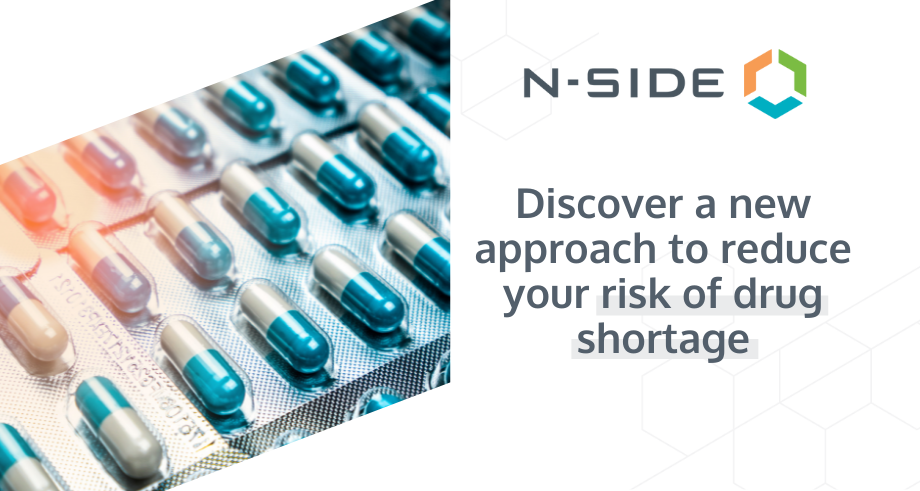How to Reduce the Risk of a Drug Shortage in Your Clinical Trial


Drug supply shortages are one of the biggest challenges in clinical trial supply management. They’re also unsettlingly common: In a poll conducted by N-SIDE, 83% of pharmaceutical companies reported experiencing supply chain risks in the past 24 months.
Even with the most careful planning, unexpected events can cause drug supply to become dangerously low. In the best cases, shortages can be averted by extending trial timelines or increasing spending. In the worst cases, potentially life-saving drugs can become unavailable to patients, risking their treatment and the success of the trial.
Thankfully, by taking a risk-based approach to clinical trials, trial managers can now use optimization tools to minimize the risk of supply shortages.
What causes drug shortages in clinical trials?
There are many reasons that could bring a clinical trial to a drug shortage situation.
Batches failing to meet quality standards, commercial shortages of comparator drugs, expiry events, and expiry reductions can all lead to availability problems. The long timelines typically associated with clinical trial drug production can exacerbate these issues.
Higher-than-forecasted patient demand can also lead to shortages. Patients might be recruited faster, stay active longer, weigh more, or change to different dose levels more frequently than expected. Trial protocol amendments can also impact patient demand.
At the depot and site level, unexpected events such as temperature excursions or non-optimal configuration of the interactive response technology (IRT) software can lead to higher than expected wastage and cause a shortage.
Breakdowns in logistics, customs delays, and the impact of local regulations can also put pressure on the supply chain. Recent examples of such breakdowns occurred due to Brexit and the COVID-19 pandemic.
How do companies typically reduce their risk?
Drug shortage avoidance strategies should be included in any clinical trial risk management plan.
When the risk of a shortage is identified, the trial managers have to take action to mitigate that risk. This is tricky — do too little, and the drug shortage may not be avoided. Do too much, and they risk slowing down the trial and increasing costs.
There are typical go-to mitigation strategies that supply managers tend to implement right away:
- Updating the IRT configuration to minimize drug transfers to sites
- Slowing down or halting the recruitment
- Performing depot-to-depot shipments
Slowing down recruitment is generally a solution we all want to avoid. But, actually, there are hundreds of other ideas that could help solve this shortage risk. Some will not solve the problem by themselves but, combining them with others might just be right.
Overcompensating is also common in those cases - implementing risk mitigation strategies that are too powerful would actually create missed opportunities by delaying the clinical trial timelines or increasing costs and waste needlessly.
Can clinical supply forecasting help?
Many pharmaceutical companies use clinical supply forecasting tools to predict demand and produce the right amount of trial drug, with overage to cover unexpected events.
In theory, this should help reduce the risk of drug shortages. However, as our survey results show, this strategy doesn’t always work and unexpected events are a regular occurrence. So what’s the problem?
While clinical trial supply forecasting systems help with trial planning, the algorithms behind them are often too simplistic, and don’t take sources of uncertainty and variability into account.
Learn more: Simplicity vs. Reliability in Clinical Supply Forecasting
The solution: risk-based optimization
The key to mitigating drug shortages, or proactively planning for a risk-free strategy, without incurring excessive costs or delays is to take a risk-based approach to clinical trials supply chain.
Risk-based optimization solutions do more than simply forecast demand. They assess risks before the trial starts and during the trial, using advanced analytics to both identify shortage risks and suggest the most effective strategies for mitigating these risks. This is accomplished by performing sensitivity analyses through simulation and identifying the most important causes of risk in each unique trial.
For example, a risk-based optimization solution can quantify the impacts of COVID-19-related shipment delays, protocol amendments, bad production batches, and more on the risk of a stockout or missed dispensing.
The solution can then quantify the impacts of different mitigation measures on these risks, trial costs, and timelines. This allows trial managers to make informed decisions about whether to update the IRT system, perform depot-to-depot shipments, or pause recruitment.
The N-SIDE Supply App
The N-SIDE Supply App is currently the only risk-based optimization solution for clinical trial supply management. It models the trial design accurately and simulates the uncertainties at each stage. Shortage risk is identified, quantified, located, and reported, whatever its cause.
N-SIDE was recently called upon to advise a biotech company that had concerns about a large clinical trial they were involved with. The trial had already been running for six months, with 45% of sites already open.
Using the Supply App, we discovered an impending drug shortage due to longer patient treatment, faster-than-expected enrollment, and a commercial shortage of chemotherapy. The shortage would have led to 425 patients missing drug doses within two months of the evaluation — a risk to their wellbeing, and likely a fatal blow for the trial.
We were then able to use risk-based optimization to recommend mitigation measures, including:
- Closing 25 low-performing sites
- Re-labeling brite stocks initially allocated to another trial
- Keeping stocks at the local depot to increase flexibility
- Optimizing the IRT algorithm
We were also able to collaborate with the contract research organization (CRO), their client, and the contract manufacturing organization (CMO) to choose and develop the most feasible solutions, accelerate packaging and release timelines, and redistribute the available medication to the right locations.
These solutions prevented the drug shortage with no impact on patients, with an additional benefit of saving the company more than $4 million in future sourcing by re-optimizing the supply strategy. Enrollment continued as planned, and the trial was able to finish on schedule.
It’s worth noting that this biotech company only started performing risk-based optimization after the trial had begun. Had risk been proactively assessed before it started, it’s likely the company would not have been in such a stressful situation, and would also have achieved additional cost savings.
Learn more about using risk-based optimization to prevent drug shortages:



About the Author
Amaury is N-SIDE's Strategy Advisor for clinical supply chain solutions. Within his 9 years in the industry, Amaury’s objective has been to revolutionise planning and systems to make clinical supply chain more efficient, more ethical, less wasteful and more patient-centric.
Amaury Jeandrain


